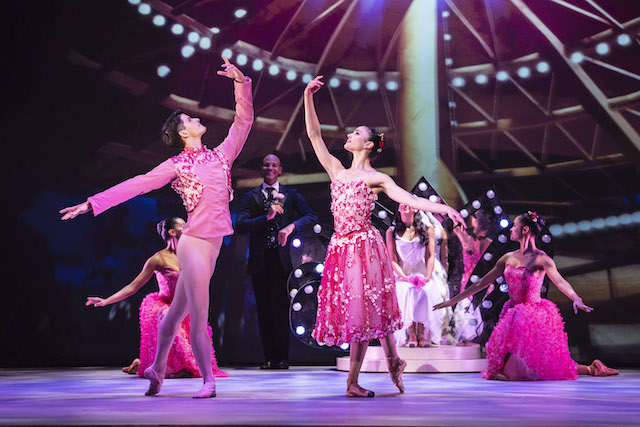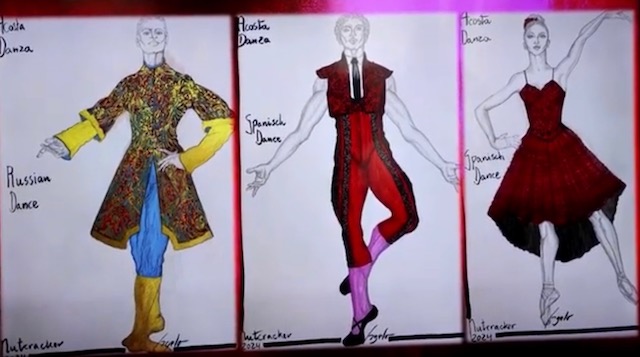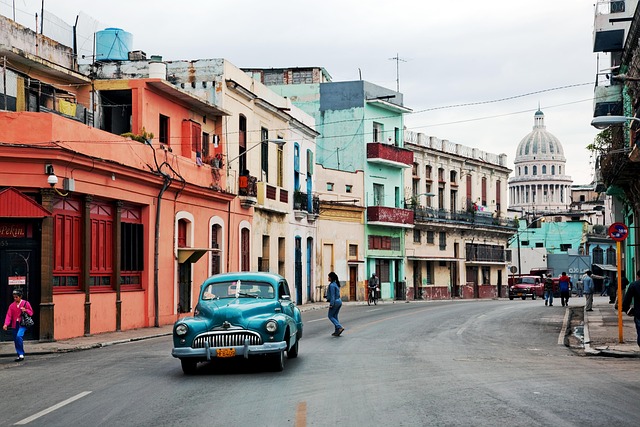Last night, I had the joy of watching the opening of Nutcracker in Havana by Carlos Acosta at Queen Elizabeth Hall, Southbank Centre, and what a dazzling festive treat it was! As someone who’s seen The Nutcracker almost every year in London over the past decade, I’ve grown accustomed to the classic, traditional renditions – all snowflakes, sugar plums, and Tchaikovsky in its purest form. Acosta’s version, however, adds a bold splash of Caribbean sunshine to this European classic, making it a vibrant departure from the usual.

Flower couple Enrique Corrales, Patricia Torres, with Alexander Varona as Drosselmeyer, Ofelia Semanat, Cynthia Laffe in Nutcracker in Havana – Credit: Johan Persson
From the moment the curtain rose, I was transported to a lively Cuban Christmas. The show opens with a stunning postcard of Havana, followed by projections that capture both the bustling cityscape and lush rural landscapes. But it’s not just the visuals that whisk you away. The reimagined score, orchestrated by Pepe Gavilondo and Yasel Muñoz, is infused with Latin rhythms and local instruments, creating a festive party vibe. It’s daring, yes, but it works brilliantly.
Acosta has kept the heart of the traditional story intact, but with his unmistakable flair. Uncle Elias (a Cubanised Drosselmeyer) arrives in a self-driving vintage Chevrolet, bedazzled in a sparkling waistcoat, and his magic fills the stage with bright costumes, a grand staircase, and a towering tree. The choreography is a joyful blend of classical ballet with playful Cuban twists. There’s a delightful maypole dance, clog-like sandals, and even a touch of martial arts in the second act’s Land of Sweets. Lauretta Summerscales as the Sugar Plum Fairy was nothing short of breathtaking – graceful, confident, and utterly radiant.
But here’s where I think Acosta could go even further. While the production brims with Cuban energy, I found myself longing for more salsa and cumbia influences in both the dances and the music. The experiment is a triumph, and it’s time to be even bolder. Next year, Acosta, let’s turn up the heat and truly Cubanise the entire show!
The costumes deserve their own standing ovation – some of the most fabulous I’ve ever seen, sparkling and vibrant, perfectly capturing the spirit of Havana. Nutcracker in Havana is a family-friendly production that feels fresh, festive, and full of heart.

If you’re looking for a Christmas show with a twist, Nutcracker in Havana will leave you smiling and tapping your toes. Carlos Acosta has brought sunshine, salsa, and snow together in a way that’s as heart-warming as it is daring. Bravo!
Catch the Acosta Danza tour across the UK until 28 January 2025 – and prepare to fall in love with Christmas, Cuban-style. Tickets from here.
Christmas in Cuba: A celebration revived
Christmas in Cuba has a unique history, shaped by decades of cultural and political change. It’s celebrated with a vibrant mix of traditions, reflecting the island’s rich cultural tapestry, but it hasn’t always been this way. For almost three decades, Christmas was officially banned in Cuba, a reality that deeply affected the way the holiday was observed – or not observed – across the country.
The ban on Christmas dates back to 1969, during the regime of Fidel Castro. The government declared it a working holiday, citing the need to prioritise the sugar harvest, a cornerstone of the Cuban economy at the time. The removal of Christmas from the national calendar was also part of a broader effort to secularise the country and diminish religious influence, in line with Cuba’s official atheist stance after the revolution.

Image by Falkenpost from Pixabay
For nearly 30 years, public celebrations of Christmas were rare. Churches could still hold services, but most Cubans refrained from open festivities, and Christmas trees or lights were almost non-existent. For many, the holiday became a quiet family occasion behind closed doors, if it was marked at all.
Carlos Acosta said: “With Nutcracker in Havana I wanted to give the Cuban people the Christmas they never had. We started to celebrate Christmas from the coming to the island of Pope John Paul II in 1998 because before that Christmas was banned.”
Christmas was, in fact, reinstated as a public holiday in 1998, following a visit from Pope John Paul II. His influence on Cuban society led to the restoration of Christmas, both as a religious celebration and as a national holiday. The 25th of December became a day for family gatherings, rest, and festivities, gradually growing into a more prominent occasion once again.
How is Christmas celebrated in Cuba today?
Cuban Christmas celebrations today remain relatively understated compared to the grand displays seen in many other countries, but they are deeply meaningful. The main celebration, Nochebuena (Christmas Eve), focusses on a big family meal. Traditional dishes include roast pork, rice and beans, yucca with garlic sauce, fried plantains, and salad. For those who can afford it, the menu might also include turkey and other festive treats.
The festivities tend to be more about togetherness and community than commercialisation. Christmas trees, often artificial and colourfully decorated, can be found in homes and public spaces, but the scale of decoration is modest due to economic constraints.
In the town of Remedios, Christmas is marked by Parrandas de Remedios, one of the most famous celebrations in Cuba. This lively tradition features a spirited competition between neighbourhoods, with fireworks, music, and elaborate floats. The Parrandas originated in the early 19th century when a local priest encouraged noisy celebrations to draw people to midnight mass.
The history of Christmas in Cuba reflects the resilience of Cuban culture and the way traditions adapt to political and social change. Today, while the celebrations may not rival those of other nations in extravagance, they carry a unique charm that blends family warmth, historical significance, and festive joy. Whether marked with quiet reflexion or lively street parties, Christmas in Cuba remains a testament to the enduring spirit of the holiday.



